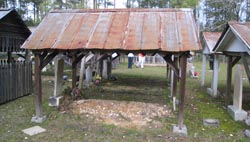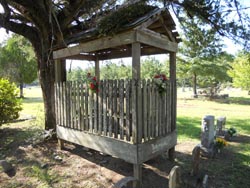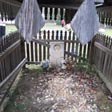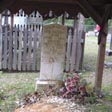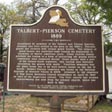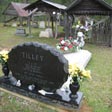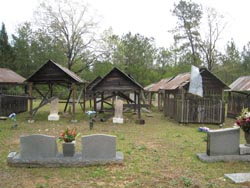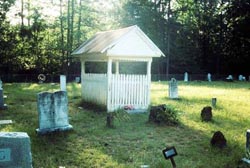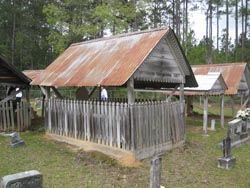In My Father's House: North Louisiana Gravehouses as Art and Technology
By Marcy Frantom
Most people can't tell you what the little wood houses with picket fences built over graves are called, but recognize something familiar when they spot one in a photo of a Methodist or Baptist country cemetery. Strangely enough, they've become a part of what we consider things southern, but we still don't know exactly who made them or what they were supposed to represent. We don't know whether the memorials were a fad brought on by easy access to virgin lumber and the widespread use of the scroll saw, or whether they were deeply traditional to several folk groups settling in Louisiana. To make matters worse, scholars began to notice gravehouses only after most of the tradition was already gone—those who made them had moved away or died, rural communities quit taking care of their local cemeteries, and most of the gravehouses, many more than 100 years old, had fallen down or been destroyed.
We have learned some things about them, however. The typical north and central Louisiana gravehouse is found in Anglo Protestant country cemeteries, and consists of a roof supported by upright posts and cross-members bearing fence pickets. The shingle roof usually had fern growing on it and a cedar tree planted at the head. Local people say they protected graves from excessive settling, but their primary function was to protect graves from desecration by animals before cemeteries were fenced. However, at least two other traditions were also practiced in Louisiana. Solid wall gravehouses were built in South Louisiana in predominately Catholic cemeteries, and are reported to have been built to "keep rain off the face" of the deceased. Louisiana Native Americans also probably practiced a tradition in which the structures functioned as spirit houses. While many cultures worldwide have used house-shaped memorials, they probably have different uses and meanings even when the objects were similar.
Luckily, there are a good number of north and central Louisiana gravehouses still in existence to compare and see what sort of variation occurs. One thing that happens from about 1870 to 1900 is that they change from low, small, enclosed wooden houses made mostly of hand-split wood to larger open structures decorated with ready-made bric-a-brac. After 1900, people quit using the surrounding pickets and the structures became sheds with shells, bulbs, and ceramics decorating the interior. The pickets were probably no longer necessary because most of the cemeteries were fenced by then, and the Stock Law limited the grazing of livestock. More people recall them being called "shed" than anything else.
While the shapes of gravehouses have changed over time, the people who are honored by them have not. They are usually special people—small children, mothers who died young, and soldiers. Locals seem to think that the troubles in upkeep for gravehouses are justified when the person died tragically or in a special situation. Some gravehouses cover family plots, but in most cases at least one small child is included among the burials. Local stories commemorate these special people and are told at cemetery homecomings when the graves are maintained. These stories are dramatic and provide a sense of history for the community. For example, a young boy dies in a fire (some versions blame his mother's carelessness) and is buried in the woods protected by a gravehouse. Fires that sweep through the woods leave the gravehouse untouched. Another story tells of two little boys who serve as flag bearers for their father's confederate unit and are killed in battle. In some cases, the story may be recalled even after the gravehouse no longer exists.
Another part of the gravehouse tradition that holds true is their function as a technological device to protect graves from molestation by animals. Before World War II, country people took care of the burials of their relatives and friends. They understandably had a horror of the graves being disturbed, and relied on folk practices to guide them in these matters. They brought many useful ideas for protective devices with them from Europe—above ground brick or rock vaults, rock cairns, slabs over the grave called "wolf stones," low stone roofs known as "hog-back tombs," wrought iron "safes" placed over graves to protect from robbers, board fences on the center of the grave, vine "wattling" baskets over the body, and brick or stone fencing. In North Louisiana, protective devices such as cairns were preferred as more permanent; however, wooden gravehouses were used where rock was not available. For families increasingly on the move after the Civil War, they were "perpetual care" memorials.
In addition, the artistic opportunity of gravehouses was not lost on the master carpenters who built them. They may have been expressions of "heavenly homes" which appeared in popular hymns or the Bible verse John 14:2 (noted in one gravehouse at Sikes): "In my Father's house are many mansions: if it were not so, I would have told you. I go to prepare a place for you." The materials are usually the same as those used on a house of the period. Some are well finished with beaded board ceilings; pineapple, diamond, or willow topped pickets; scrollwork around the eaves; and a clock on the gable. The interior could be decorated like a garden with bulbs, honeysuckle vines, or ceramic objects. While the basic shape was ordained by popular consensus, the selection of details was left up to the craftsman. Gravehouses were built to be functional but also could be beautiful. And they could also be continually redecorated as future generations added a coat of white paint or replaced a shingle roof with bright green roofing material.
Lately people have become interested in maintaining or rebuilding the gravehouses that survive as a way to commemorate the pioneer settlers who built north and central Louisiana. The structures give us insight into the way in which our ancestors approached their necessities with technological innovation and graceful artistry.


